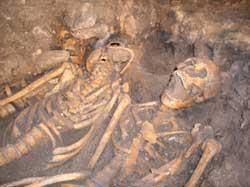http://www.yorkpress.co.uk/news/916452.skeletons_of_bloodiest_day/
8:36am Tuesday 12th September 2006 in News By Nadia Jefferson-Brown, nadia.jeffersonbrown@thepress.co.uk
By Nadia Jefferson-Brown, nadia.jeffersonbrown@thepress.co.uk
 By Nadia Jefferson-Brown, nadia.jeffersonbrown@thepress.co.uk
By Nadia Jefferson-Brown, nadia.jeffersonbrown@thepress.co.uk
SKELETONS bearing marks of horrendous sword injuries have been unearthed beneath a North Yorkshire hall.
The victims of a medieval battle were discovered beneath the floor of the dining room of Towton Hall, between Tadcaster and Sherburn-in- Elmet, dating from the Battle of Towton in 1461.
The discovery was made as part of a ten-year investigation into the archaeological evidence of the longest and bloodiest battle ever fought in England.
Taking place on Palm Sunday, March 29, 1461, the Lancastrian army was handed an enormous blow
with its leader, King Henry VI, forced to flee. He was defeated by the self-proclaimed Edward IV.
After ten hours of combat at the battle, near Tadcaster, 28,000 men lay dead. The latest find was instigated following the unearthing of a mass grave at the hall in 1996, which contained 37 battle victims.
The latest evidence and gruesome accounts of the War Of The Roses clash, and its victims will be presented at a one-day conference on Wednesday, October 4, at 9.30am at the Yorkshire Museum in York. Tickets are £19.50.
The Battle of Towton took place in a snowstorm, between the villages of Towton and Saxton, about two miles south of Tadcaster.
The Towton Battlefield Archaeological Survey, directed by Tim Sutherland, of the University of Bradford, has reassessed evidence of the battle through large-scale investigations across the battlefield landscape and has re-evaluated the documents.
The project, the first multidisciplinary investigation of a medieval battlefield in this country, has also discovered large numbers of arrowheads and further mass graves, making it possible to accurately locate the site of the battle. Further work in the area of Towton Hall has also led to the unearthing of several single graves of combatants.
The most recent excavation, funded by the Royal Armouries, Leeds, under the dining room of Towton Hall revealed a further multiple grave containing soldiers with battle injuries.
It is possible these are the remains of high-ranking combatants buried on what was later to become the site of King Richard III's chantry chapel built to commemorate the conflict.
No comments:
Post a Comment